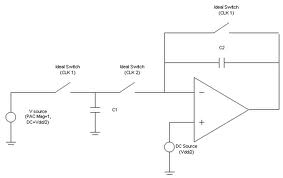Hi,
This is Jyothi, an MTech student from India. We are trying to design a switched capacitor amplifier with gain of 100 . We have done a normal inverting amplifier using opamp and resistors (Ri=1kohm and Rf=100kohm) and we are getting the output. But once we replace all resistors with switched capacitors, we are getting some weird output. Our input is a sine wave of frequency 1MHz and peak-peak amplitude 2mV centered around 2.5V and the frequency of non-overlapping clocks is 2MHz. Our supply is 0-5V. What could be the issue? We are unable to fix it. What is the kind of output that we should expect. Please help. Could you kindly share a commonly used SC Amplifier circuit. We are trying to simulate the circuit in HSpice. Please find the attached for the circuit we are using.
Thanks,
Jyothi

